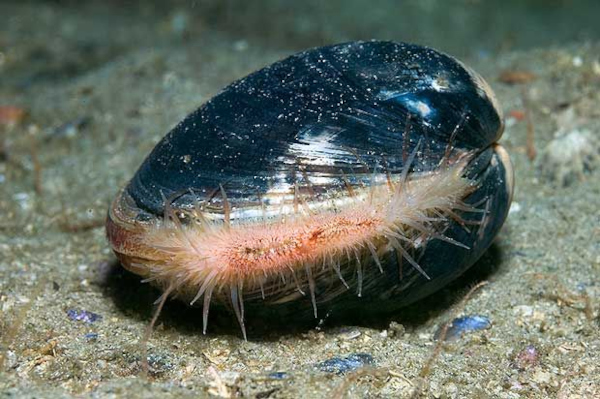Black clam is one of the most important clam species contributing to more than 70% of clam fisheries in India. A research team in India has concluded that black clams (Villorita cyprinoides) can provide potential early warning information on marine pollution that can help environmental scientists to monitor and manage the overall fitness of the marine environment.
In this integrated study involving observation of critical bio-lethal parameters coupled with a bioassay of the black clams, sensitive information could be obtained by the scientists. Results of the study revealed that information on sublethal exposure of metal lead (Pb) and its toxic effects on the black clam is an important precursor to assess pollution in a marine environment. The study also helped them to make a reliable risk assessment of other aquatic lives for enforcing stringent water quality management practices.
The study showed that there was significantly higher pollution of heavy metals in the northern parts of the estuarine system water sample of the southwest coast of India during pre-monsoon, followed by monsoon and post-monsoon, except for lead and nickel. The research revealed that the alterations in antioxidant enzyme activities in black clams may lead to biochemical senescence. The utility of the study of cellular, physiological, biochemical, and histopathological biomarker responses was established in the study that can be used to monitor aqueous contamination of heavy metal.
The study found a significant increase in the concentration of leads (Pb) in the bodies of clams after chronic exposure. Even a small concentration of lead in the estuary can lead to many-fold increase in its concentration in black clams which may damage the genetic materials, proteins and lipid and lead to health risks to other marine organisms including humans consuming them.
Black clam is one of the most important clam species contributing to more than 70% of clam fisheries in India. A research team in India has concluded that black clams (Villorita cyprinoides) can provide potential early warning information on marine pollution that can help environmental scientists to monitor and manage the overall fitness of the marine environment.
As per researchers, metal concentration was found to be higher in the sediment during pre-monsoon and post-monsoon periods, except for lead and nickel in the estuary which might be due to the weaker flushing leading to the entrapment of metals in the sediment. Over a longer period, they can therefore help prevent the spread of harmful metal sediments into waterways used by local communities. A reduced discharge from the Periyar River was observed during the study, which may also lead to the increasing concentration of metals during pre-monsoon in the sediment.
The researchers of this study affiliated with the National Center for Coastal Research (NCCR), Chennai and Cochin University of Science and Technology (CUSAT), Kerala, found a direct correlation between the degree of industrialization and contamination of the Cochin Estuarine System (CES) of India’s southwest coast by heavy metals leading to metabolic stress in black clams.
In this study, researchers used black clams Villorita cyprinoides transplanted from relatively clean waters of the Cochin Estuarine System to assess lead (Pb) metal concentration at a coastal area of Cochin on the southwest coast of India. It is an industrially active zone along with CES on the bank of the Periyar river which releases nearly 0.105 million m3/day of effluents affecting aquatic organisms and ecosystems. The research findings are published in the journal of Environmental Science and Pollution Research.
Human health is threatened due to exposure to heavy metals like lead, cadmium, and mercury as these metals accumulate in the original food chain moving up through higher trophic levels with negative effects on marine resources. Therefore, researchers propose that this evidence should be used as an input for public policy decisions to reduce the effects of human activities on coastal and marine ecosystems.
Led by S. Bijoy Nandan, the research team comprised of K.V. Neethu, N.D. Don Xavier, P.R. Jayachandran, P.R Anu, and A.M Midhun of Department of Marine Biology, Microbiology & Biochemistry, School of Marine Sciences, CUSAT, Cochin, D. Mohan, S.R. Marigoudar NCCR, Ministry of Earth Sciences, Chennai.
Source : Vigyan Prasar
You may also like
-
New Heat-Based Approach To Cancer Treatment Can Reduce Chemotherapy Doses
-
Scientists Take A Major Step Towards Unification Of Classical & Quantum Gravity
-
India Graphene Engineering and Innovation Centre (IGEIC) Under the Vision of Viksit Bharat@2047 Launched
-
New High-Performance Gas Sensor can Monitor Low Level Nitrogen Oxides Pollution
-
Antidepressant Drug can be Repurposed for Treating Breast Cancer
